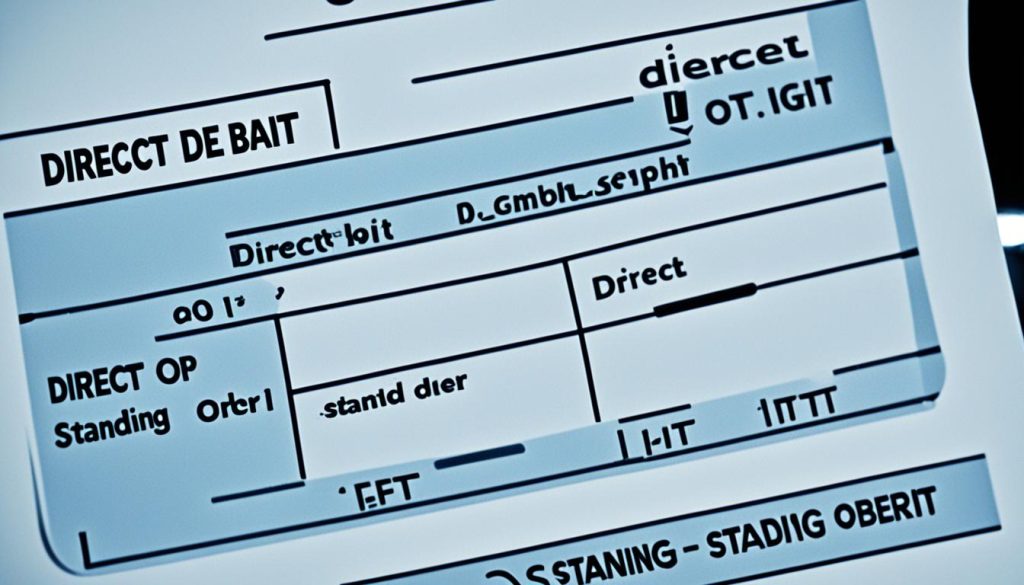Welcome to our guide on Direct Debit vs Standing Order, two popular automatic payment methods. In this article, we will compare these payment options to help you make the right choice for your needs. Whether you’re an organization considering which method to offer your customers or an individual looking to set up automatic payments, understanding the differences between Direct Debit and Standing Order is crucial.
Direct Debit and Standing Order are both convenient ways to automate regular payments, but they have some important distinctions. Let’s explore the key differences, benefits, and how to set them up. By the end of this article, you’ll have a clear understanding of each payment method and be able to decide which one suits you best.
Before we dive into the details, let’s briefly explain what Direct Debit and Standing Order are and why they are commonly used in the United Kingdom.
What is Direct Debit?
Direct Debit is an automated payment method that offers numerous benefits for both organizations and customers. When a customer signs up for Direct Debit, they authorize the organization to collect money directly from their bank account whenever a payment is due. This eliminates the need for manual payments and ensures that payments are never missed.
One of the main advantages of Direct Debit is its convenience. Customers no longer have to worry about remembering to make payments on time or going through the hassle of setting up recurring payments each month. Once the authorization is in place, the payments are automatically deducted from the customer’s account, saving them time and effort.
Another benefit of Direct Debit is its flexibility. Unlike other payment methods, such as standing orders, the amount and frequency of Direct Debit payments can be adjusted by the organization without requiring additional authorization from the customer. This allows for easy modifications to payment schedules, ensuring that they align with the customer’s needs and financial situation.
In addition to convenience and flexibility, Direct Debit payments are protected by the Direct Debit Guarantee. This guarantee provides customers with the peace of mind that if there are any errors or unauthorized withdrawals, they will be entitled to a full refund. The Direct Debit Guarantee acts as a safeguard, ensuring that customers are protected from any potential mishaps.
Overall, Direct Debit is a secure and efficient method of payment that offers convenience, flexibility, and peace of mind for both organizations and customers.

| Benefits of Direct Debit |
|---|
| Convenience |
| Flexibility |
| Direct Debit Guarantee for added security |
What is a Standing Order?
A standing order is an automated payment method set up between a customer and their bank to send fixed payments to specific recipients at regular intervals. Unlike Direct Debit, the customer has full control over the amount and frequency of the payments and can change or cancel them without notifying the recipient. Standing orders are commonly used for paying rent, mortgage payments, and other regular expenses. They offer stability and predictability but may lack the flexibility of Direct Debit.
Standing Order Basics
A standing order is a financial arrangement where the customer instructs their bank to make recurring payments to a specified recipient. The customer determines the amount and the frequency of the payments, ensuring that the recipient receives the payment promptly and consistently.
Setting up a standing order is a straightforward process. The customer provides their bank with the necessary details, including the recipient’s account number and sort code, the payment amount, and the frequency of the payments. The bank then executes the payments according to the customer’s instructions.
Benefits of Standing Order
Standing orders offer several benefits to both customers and recipients. Here are some key advantages:
- Control: Customers have complete control over the payment amount and frequency. They can adjust or cancel the standing order at any time without notifying the recipient.
- Predictability: Recipients can rely on receiving fixed payments at regular intervals, making it easier to plan and manage their finances.
- Stability: Standing orders provide stability and ensure consistent payment for regular expenses such as rent, mortgage payments, or subscription fees.
However, it’s important to note that standing orders may lack the flexibility offered by Direct Debit. Changes to the payment amount or frequency require manual intervention by the customer. Additionally, standing orders do not come with the same level of protection as Direct Debit payments, such as the Direct Debit Guarantee.
Example of Standing Order:
| Payment Recipient | Payment Amount | Payment Frequency |
|---|---|---|
| ABC Ltd | £500 | Monthly |
| XYZ Charity | £50 | Quarterly |
| Alpha Services | £100 | Bi-annually |
In the example above, the customer has set up standing orders to make monthly payments of £500 to ABC Ltd, quarterly payments of £50 to XYZ Charity, and bi-annual payments of £100 to Alpha Services. These payments are sent automatically based on the specified frequency, providing stability for both the customer and the recipients.
Direct Debit Vs Standing Order – Key Differences
When it comes to choosing the right payment method for recurring payments, Direct Debit and Standing Order have some key differences that are important to consider. Understanding these differences will help you make an informed decision based on your specific needs and requirements.
Control:
One of the main differences between Direct Debit and Standing Order lies in the level of control each method offers. With Direct Debit, the organization has control over the payment amount and frequency, as they set up and manage the payment schedule. On the other hand, with a Standing Order, the customer has full control over the payment amount and frequency. They can easily change or cancel the standing order without notifying the recipient.
Security:
Direct Debits are generally considered more secure than Standing Orders. This is because Direct Debits are protected by the Direct Debit Guarantee, which ensures that customers are entitled to a refund in case of any incorrect payments. Standing Orders, on the other hand, do not have the same level of protection, as the responsibility lies with the customer to ensure the accuracy of the payment details.
Flexibility:
When it comes to flexibility, Standing Orders offer more options than Direct Debits. Customers have the freedom to change or cancel their standing orders at any time without needing to inform the recipient. This provides greater flexibility and control over the payment process. On the other hand, Direct Debits offer less flexibility, as any changes to the payment amount or frequency need to be authorized by the organization.
Automatic Payments:
Direct Debits are collected automatically from the customer’s bank account on the scheduled dates. This eliminates the need for manual intervention and ensures that payments are not missed. In contrast, standing orders require manual intervention from the account holder to initiate the payment. This means that the customer needs to ensure that the payment is made on time.
By understanding these key differences, you can choose the payment method that best suits your needs. Whether you prioritize control, security, flexibility, or automatic payments, both Direct Debit and Standing Order offer unique benefits. Consider your specific requirements and preferences to make an informed decision that ensures smooth and hassle-free recurring payments.

How to Set Up Direct Debit and Standing Order?
Setting up a Direct Debit is a straightforward process that requires the customer to provide their bank details to the organization and authorise them to collect payments. Once the authorisation is given, the organization can set up the Direct Debit using a secure system such as GoCardless. This system ensures that the payments are collected automatically on the scheduled dates, providing a convenient and hassle-free payment solution.
On the other hand, setting up a standing order involves the customer filling in a form provided by their bank. The completed form is then sent or submitted to the bank for processing. The bank will then set up the standing order according to the customer’s instructions and make the payments at the specified intervals. This manual process may require a bit more effort from the customer’s side but provides them with control over the payment scheduling options.
To summarize, setting up a Direct Debit requires the customer’s authorization and the organization’s setup using a secure system. In contrast, setting up a standing order involves the customer filling in a form provided by their bank and submitting it for processing. Regardless of the method chosen, both Direct Debit and standing orders offer effective payment scheduling options to suit the customer’s needs.

Choosing the Right Option for Your Needs
When deciding between a standing order and a direct debit, it’s essential to consider various factors to choose the right option for your needs. These factors include the size of your organization, the customer base you serve, and the nature of the payments you deal with.
For smaller organizations with a limited number of customers, standing orders can be a suitable choice. With standing orders, you have control over the payment amount and frequency, allowing for more flexibility in managing your finances. It’s a reliable option for fixed payments, such as rent or mortgage payments.
However, as your organization grows and handles a larger customer base, direct debit offers increased convenience and reliability. With direct debit, the organization has control over the payment amount and frequency, ensuring consistent and timely collections. It eliminates the need for manual intervention and reduces the risk of missed or late payments.
If you have a high level of trust and reliability with your customers, standing orders can work well. It allows them to have greater control over their payments and can be beneficial for long-term relationships. They can easily make changes or cancel standing orders without notifying you, providing them with flexibility.
On the other hand, if you deal with variable payments or require more control and flexibility, direct debit is the better option. With direct debit, you have the ability to adjust the payment amounts and frequencies as needed, providing greater control over your cash flow. It ensures smooth and efficient payment processing, especially if you have a large number of recurring payments.
To choose the right option, carefully weigh the benefits and disadvantages of each payment method. Consider your organization’s specific requirements, the level of trust and flexibility needed, and the size and nature of your customer base. By evaluating these factors, you can make an informed decision that aligns with your needs and facilitates smoother financial management.

| Factors | Standing Order | Direct Debit |
|---|---|---|
| Control over payment amount and frequency | ✔ | ✘ |
| Convenience and reliability | ✘ | ✔ |
| Flexibility for changes or cancellations | ✔ | ✘ |
| Adjustability for variable payments | ✘ | ✔ |
Choosing the Right Payment Method
Consider your organization’s specific needs and evaluate the following:
- Size of organization
- Customer base
- Nature of payments
Based on these factors, reflect on the benefits and disadvantages of standing orders and direct debits.
For smaller organizations or fixed payments, standing orders offer control and stability, while direct debits provide convenience and automation for growing organizations or variable payments.
Conclusion
In conclusion, both Direct Debit and Standing Order are automatic payment methods with their own advantages and disadvantages. Direct Debit offers several benefits that make it a popular choice among organizations and customers. It provides convenience by eliminating the need for manual payments and offers flexibility as the payment amount and frequency can be adjusted by the organization. Moreover, the Direct Debit Guarantee ensures secure transactions and provides peace of mind to customers.
On the other hand, standing orders offer stability and control for regular, fixed payments. They allow customers to have full control over the payment amount and frequency, giving them the freedom to make adjustments or cancel the standing order at any time. However, standing orders may lack the same level of flexibility as Direct Debit and require manual intervention by the account holder.
The right choice between the two depends on individual needs and preferences. Factors such as organization size, customer base, and payment requirements should be taken into consideration. To make an informed decision, it is recommended to consult with your bank or financial institution as they can provide guidance on which payment method best suits your needs.
FAQs
What is the difference between Direct Debit and Standing Order?
Direct Debit is set up by the organization and they manage the payments, while a Standing Order is set up by the customer and they have control over the payments.
What are the benefits of Direct Debit?
Direct Debit offers convenience, flexibility, and security. It eliminates the need for manual payments, allows for adjustments to payment frequency and amount by the organization, and is protected by the Direct Debit Guarantee.
What are the benefits of a Standing Order?
Standing Orders provide stability and predictability. They give the customer full control over the payment amount and frequency and can be changed or canceled without notifying the recipient.
How do I choose the right option for my needs?
The choice depends on factors such as the size of the organization, the customer base, and the nature of the payments. For smaller organizations or fixed payments, standing orders may be suitable, while Direct Debit offers convenience and reliability for larger organizations or variable payments.





